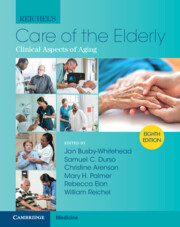Book contents
- Reichel’s Care of the Elderly
- Reichel’s Care of the Elderly
- Copyright page
- In Memoriam
- Contents
- Contributors
- Section I General Approach to the Care of the Elderly
- Section II Geriatric Syndromes
- Section III Care of the Elderly by Organ System
- Section IV Principles of Care for the Elderly
- Chapter 46 Surgical Principles
- Chapter 47 Rehabilitation
- Chapter 48 Geriatric Sexuality
- Chapter 49 Aging in Adults with Intellectual Disabilities and Severe and Persistent Mental Illness
- Chapter 50 Home- and Community-Based Long-Term Care
- Chapter 51 Institutional Post-Acute and Long-Term Care Medicine
- Chapter 52 Hospital-Based Care
- Chapter 53 Introduction to Palliative Care
- Chapter 54 The Mistreatment of Older Adults
- Chapter 55 Driving and the Older Adult
- Chapter 56 Integrative Medicine
- Chapter 57 Retirement
- Chapter 58 Cultural Competence
- Chapter 59 Health Literacy
- Chapter 60 Caregiving
- Chapter 61 Practice Transformation for Better Care of Older Adults
- Chapter 62 Health-Care Organization and Financing
- Chapter 63 Ethical Decision-Making
- Chapter 64 Epidemic and Pandemic Impacts on the Elderly Population
- Index
- Plate Section (PDF Only)
- References
Chapter 64 - Epidemic and Pandemic Impacts on the Elderly Population
from Section IV - Principles of Care for the Elderly
Published online by Cambridge University Press: 30 June 2022
- Reichel’s Care of the Elderly
- Reichel’s Care of the Elderly
- Copyright page
- In Memoriam
- Contents
- Contributors
- Section I General Approach to the Care of the Elderly
- Section II Geriatric Syndromes
- Section III Care of the Elderly by Organ System
- Section IV Principles of Care for the Elderly
- Chapter 46 Surgical Principles
- Chapter 47 Rehabilitation
- Chapter 48 Geriatric Sexuality
- Chapter 49 Aging in Adults with Intellectual Disabilities and Severe and Persistent Mental Illness
- Chapter 50 Home- and Community-Based Long-Term Care
- Chapter 51 Institutional Post-Acute and Long-Term Care Medicine
- Chapter 52 Hospital-Based Care
- Chapter 53 Introduction to Palliative Care
- Chapter 54 The Mistreatment of Older Adults
- Chapter 55 Driving and the Older Adult
- Chapter 56 Integrative Medicine
- Chapter 57 Retirement
- Chapter 58 Cultural Competence
- Chapter 59 Health Literacy
- Chapter 60 Caregiving
- Chapter 61 Practice Transformation for Better Care of Older Adults
- Chapter 62 Health-Care Organization and Financing
- Chapter 63 Ethical Decision-Making
- Chapter 64 Epidemic and Pandemic Impacts on the Elderly Population
- Index
- Plate Section (PDF Only)
- References
Summary
Infectious pandemics have had a significant negative impact on economies and health-care systems around the world repeatedly throughout history. Patients with advanced age are commonly disproportionately affected by pandemics. Health-care providers for older patients may be the first to recognize emerging infectious emergencies and play a critical role for older patients during infectious threats. This chapter outlines historical infectious outbreaks, epidemics, and pandemics and their impact on older patients. The chapter further outlines the risks of pandemics to older patients, describes key response strategies, and guides preparedness of the geriatric care provider for future infectious public health emergencies.
- Type
- Chapter
- Information
- Reichel's Care of the ElderlyClinical Aspects of Aging, pp. 771 - 779Publisher: Cambridge University PressPrint publication year: 2022

